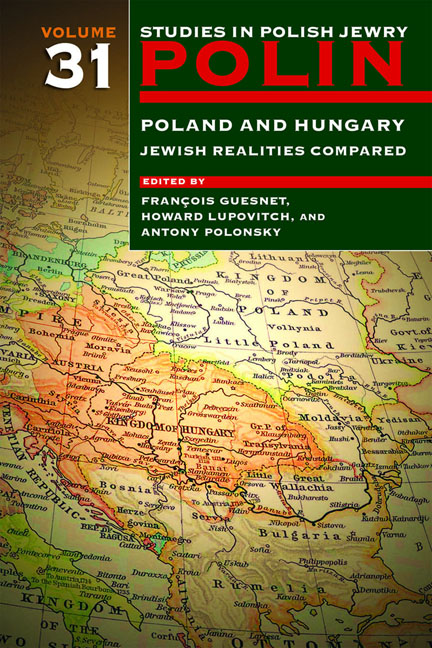Book contents
- Frontmatter
- Dedication
- Editors and Advisers
- Preface
- Polin
- Polin: Studies in Polish Jewry
- Contents
- Note on Place Names
- Note on Transliteration
- Part I POLAND AND HUNGARY: JEWISH REALITIES COMPARED
- JEWISH ACCULTURATION AND INTEGRATION
- JEWISH RELIGIOUS LIFE
- JEWS IN POPULAR CULTURE
- THE INTERWAR YEARS
- THE HOLOCAUST AND ITS AFTERMATH
- PERSONAL REFLECTIONS
- Part II NEW VIEWS
- Part III OBITUARIES
- Notes on the Contributors
- Index
Placing The Ghetto: Warsaw and Budapest, 1939–1945
- Frontmatter
- Dedication
- Editors and Advisers
- Preface
- Polin
- Polin: Studies in Polish Jewry
- Contents
- Note on Place Names
- Note on Transliteration
- Part I POLAND AND HUNGARY: JEWISH REALITIES COMPARED
- JEWISH ACCULTURATION AND INTEGRATION
- JEWISH RELIGIOUS LIFE
- JEWS IN POPULAR CULTURE
- THE INTERWAR YEARS
- THE HOLOCAUST AND ITS AFTERMATH
- PERSONAL REFLECTIONS
- Part II NEW VIEWS
- Part III OBITUARIES
- Notes on the Contributors
- Index
Summary
IN BOTH Warsaw and Budapest, fragments of the wartime ghetto walls survive in the heart of the contemporary city. In Warsaw, the best-preserved sections are reached through the courtyard of the apartment block at 62 Złota Street where the red bricks of the wall contrast strikingly with the ubiquitous post-war grey, pebbledashed facade of the surrounding buildings. In Budapest, a stretch of wall is much more immediately visible in the courtyard of the Dohány Street synagogue in central Pest where it stands as a very intentional communist-era memorial. The differing visibilities reflect the very different fates of these two ghettos. In Budapest, the ghetto walls and gates mattered in the post-war communist era due to the unique story of this ghetto being liberated—by the Red Army—rather than being liquidated and razed to the ground, as was the case in Warsaw. As the text of communist-era memorials reveals, in Budapest a story was told of the Soviets as those who broke down ghetto walls. The plaque close to one of the former gates of the Pest ghetto celebrated the moment when ‘the liberating Soviet Army broke down the ghetto walls on 18 January 1945’, while a short distance away the plaque on the stretch of ghetto wall served ‘as an eternal reminder of the day forty years ago when the wall surrounding the only ghetto remaining in Europe was broken down by the Soviet Army, liberators of our homeland’.
The language of Soviet liberation is one that was common across communist Europe, but the specificity of Budapest as the single remaining ghetto in Europe meant that this story could be, and was, celebrated on the remaining ghetto walls. In contrast, by the time the Red Army entered Warsaw, few of the city's Jews were still alive and next to nothing remained of the infrastructure of the ghetto (or the wider city). The Warsaw ghetto population were taken to Treblinka in a series of deportations beginning in the summer of 1942, and the remains of the ghetto razed when the ghetto uprising was brutally crushed in the spring of 1943. The mass deportations and Jewish uprising formed the two sides of the early post-war memorial in Warsaw by Natan Rapoport that offered a very different narrative from the early post-war memorials in Budapest.
- Type
- Chapter
- Information
- Polin: Studies in Polish Jewry Volume 31Poland and Hungary: Jewish Realities Compared, pp. 365 - 380Publisher: Liverpool University PressPrint publication year: 2018



